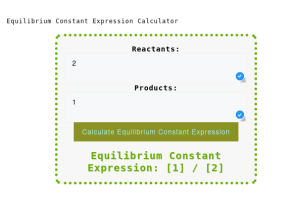Equilibrium Constant Expression Calculator
Equilibrium Constant Expression Calculator
Equilibrium Constant Expression Calculator
An Equilibrium Constant Expression Calculator is a tool used to calculate the equilibrium constant expression for a chemical reaction. The equilibrium constant represents the ratio of the concentrations or partial pressures of the products to the reactants at equilibrium. It provides insight into the extent of the reaction and the relative concentrations of the species involved.
Try our Goodwill Valuation Calculator.
Formula for Equilibrium Constant Expression:
The equilibrium constant expression for a chemical reaction is written using the concentrations (for solutions) or the partial pressures (for gases) of the reactants and products. The general formula is as follows:
Equilibrium Constant Expression = ([C]^c [D]^d) / ([A]^a [B]^b)
Where:
[A], [B], [C], [D]represent the concentrations or partial pressures of the reactants and products.a, b, c, dare the stoichiometric coefficients of the reactants and products, respectively.
The equilibrium constant expression is derived from the balanced chemical equation of the reaction. It reflects the relative amounts of each species involved in the reaction at equilibrium.
Example:
Let’s consider the following chemical reaction:
2A + 3B ⇌ C + D
The corresponding equilibrium constant expression for this reaction would be:
Equilibrium Constant Expression = ([C] [D]) / ([A]^2 [B]^3)
In this example, the stoichiometric coefficients of the reactants and products are used to determine the exponents in the equilibrium constant expression. The concentrations or partial pressures of each species are then plugged into the expression to obtain the equilibrium constant.
FAQs:
- What does the equilibrium constant tell us? The equilibrium constant provides information about the position of an equilibrium in a chemical reaction. It quantifies the ratio of product concentrations to reactant concentrations at equilibrium. The magnitude of the equilibrium constant indicates the extent to which the reaction proceeds in the forward or reverse direction.
- Can the equilibrium constant change with temperature? Yes, the equilibrium constant is temperature-dependent. Changing the temperature of a reaction can alter the value of the equilibrium constant. In general, increasing the temperature tends to favor the endothermic reaction direction, while decreasing the temperature favors the exothermic direction.
- What are the units of the equilibrium constant? The units of the equilibrium constant depend on the reaction order. For reactions involving concentrations, the units are usually expressed as (mol/L)^(Δn), where Δn represents the difference in the number of moles of products and reactants. For reactions involving partial pressures, the units are typically expressed as (atm)^(Δn).

